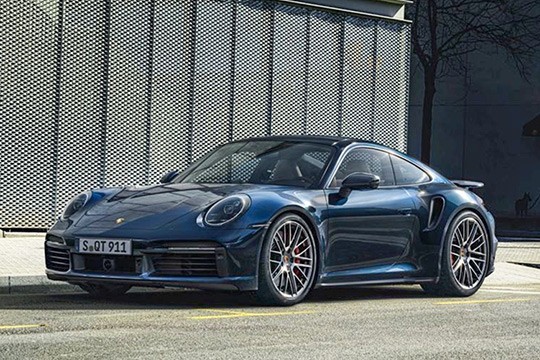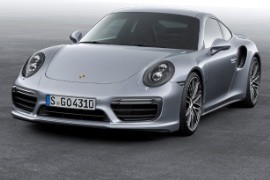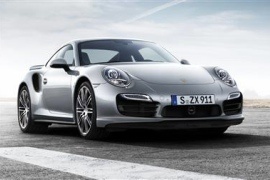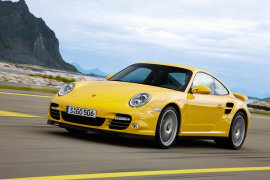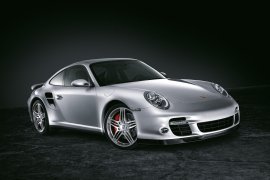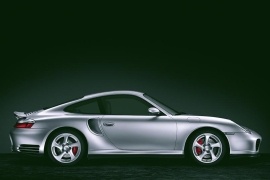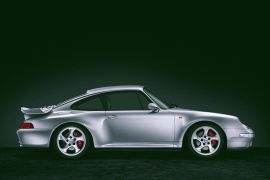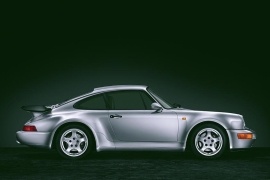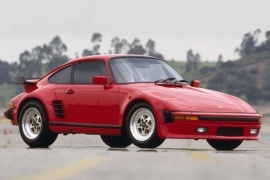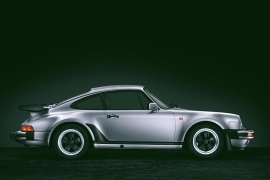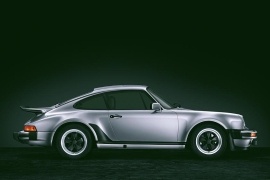PORSCHE 911 Turbo Models/Series Timeline, Specifications & Photos
First production year: 1974
Engines: Gasoline
Body style: Coupé (two-door)
With each generation of the Porsche Turbo, the car received more power and more technological enhancements. The 2020 911 Turbo was no exception, and it remained a great balance between high-performance and luxury items.
The first generation of the Turbo was introduced in 1975 and it offered 260 hp. 35 years later it added 380 hp on top of that and, since the 993 generation, an all-wheel-drive system.
The exterior might not be as aggressive as some other Porsche models, such as the GT3 or GT2, but the new front apron was a form-follow-function concept. The three big air-intakes looked like there was a trade between the engine department and the brakes department who will get more room for cooling. The car featured 20” front wheels and 21” rear wheels. Under the engine lid, the car-maker installed cooling fans and air-intercoolers. The side scoops, a characteristic for the 911 Turbo, were used to charge air. Also in the back, a big retractable wing was installed.
Inside, the Turbo featured a completely new dashboard. The tachometer was the only analog gauge in the instrument cluster. It was complemented on its sides by two other TFT displays. In the dashboard, at the same level as the sport steering wheel with paddle-shifters, there was the screen for the PCM (Porsche Communication Management) infotainment unit. A light pack offered slimmer and lighter seats, instead of the 14-way power-adjustable ones for the front occupants.
The engineering part of the car was the biggest improvement. It offered a newly developed, direct-injected 3.75-liter engine. It was fed by a pair of VTG turbochargers (variable turbocharged geometry) with a total result of 580 hp (40 hp more than its predecessor). It was paired to a standard 8-speed PDK (dual-clutch) automatic transmission with an option for a 7-speed manual.
The 991 version of the Porsche 911 Turbo was introduced in 2013 and marked the 40th anniversary of the German brand. Three years later, the glorious model was enhanced in a mild facelift.
The unmistakable shape of a Porsche 911 was one of the few in the world that didn't need a badge on it to see that there is a Porsche. The other two were the Volkswagen Beetle and the Land Rover Defender. Three iconic cars that passed the millennium border.
The facelifted version of the 991 was named 991.2. The car's front end was redesigned with side air blades and narrow LED lights, with double fillets to emphasize the car's width, as the additional fin in the main air intake. From the side, the new 20” light-alloy wheels were fitted as standard. The door handles without recess covers gave the car a sleeker look. In the back, the high-gloss chrome exhausts were specific for the Turbo version, while the stainless steel was specific for the Turbo S.
Inside, the new Porsche Communication Management (PCM) with navigation system was fitted as standard. The system featured a 7” touch-screen on the center stack. Unlike its predecessors, the new PCM featured Google Maps with real-time traffic information and Google StreetView. For the sound system, a 555 watt Bose system with 12 speakers was fitted as standard. For those who want to pay some extra for a better sound, an 821 watt Burmeister system was on the options list.
For the engine bay, the Porsche Turbo 991.2 offered 20 hp more. It was mated to a standard 7-speed automatic (dual-clutch) gearbox.
The 2013 Porsche 911 Turbo was introduced 40 years after the prototype of the 911, named 901, was unveiled at the 1963 Frankfurt Motor Show.
As usual, every 911 generation starts with the Carrera models and the Turbo version comes later. It was always the same marketing strategy and it worked well for Porsche. While in 2012 the car-maker introduced the 991 generation, with the Carrera, Targa, and Cabriolet versions, the Turbo made its way up to the public in the following year.
Since the beginning, the Turbo was considered the 911 flagship, even though it was not the quickest or the fastest car in the stable. It was the best balance between sport and luxury. It started as a true, hard-core, sports-car, but it ended up as a better GT. In the front, the Turbo was distinguished by air scoops in black in the lateral grilles and a retractable spoiler. In the rear, the wide fenders were even larger than those found on the Carrera 4 version by 28 mm (1.1”).
Inside, the front sport seats with power 14-way adjustments were fitted as standard. They featured a memory package with electric steering column adjustments. The sport steering wheel was fitted with paddle shifters for the standard 7-speed automatic PDK (dual-clutch) gearbox. In the five-dials instrument cluster, the right one was a 4.6” high-resolution color display. The PCM (Porsche Communication Management) audio featured a twelve speaker Bose Surround System, including a 100 W active subwoofer.
The drivetrain for the Turbo offered a 3.8-liter flat-six engine with direct fuel injection. It was aided by a pair of turbochargers with variable geometry. For better speed cornering, the car was fitted as standard with PASM (Porsche Active Suspension Management) and all-wheel steering.
The 2010 Porsche 911 Turbo was launched at the same time with the Cabriolet version at the 2009 Frankfurt Motor Show. Due to its 500 hp and the all-wheel-drive system, it was a four-seasons supercar.
Since the introduction of the Porsche Turbo in the 911 line-up, it was considered the flagship of the 911 armada. It was the best balance between performance, comfort, and luxury for a supercar. And, with the all-wheel-drive system, it was a true, four-seasons, supercar.
For the 2010 model, the car featured large air intakes and bar-shaped LED turn-signals. In the side-scoops air intakes needed to cool the front brakes, the designer incorporated the daytime running lights with LED, instead of the usual foglights. The headlights featured optional dynamic lights that improved illumination on the bends due to a swiveling mechanism. On the upper side of the rear fenders, a twin air-intake was placed to help to cool and feed the engine with fresh air. The wing on the engine hood made an important aesthetic difference between the Turbo and the rest of the 911 models.
The first Porsche 911 Turbo appeared in 1974 and offered a 260 hp from a flat-six 3.0-liter engine. Fast forward to 2009 and there are still 6-cylinders flat under the rear hood and the engine grew to 3.8-liter displacement. Instead of one turbo, there are two turbochargers with Variable Turbine Geometry, a feature exclusive to Porsche. It was mated to either a six-speed manual or a 7-speed PDK (Dual-clutch automatic gearbox).
It was the sixth generation of the Porsche Turbo and it had to offer more than any other 911, for street use. It wasn't a race-car, but a supercar dressed as a GT vehicle. And it was good at both.
In February 2006, Porsche unveiled the Turbo at the Geneva Motor Show. It looked more aggressive than its Carrera siblings. The air-intakes on the rear fenders told the world that the 911 was back and promised to offer exhilarating performance on the street and to be a fierce competitor on a track for a weekend race.
On the front, a new bumper with LEDs incorporated into the outer air inlets was designed. The center grille was as wide as it could, without interfering with the side scoops needed to cool the brakes. A new set of sills was installed and, on the wide rear wheel-arches, the split air-intake made a good impression. At the back, an extendible split-wing was installed. It was risen at speeds over 120 kph (75 mph) and retracted at speeds under 80 kph (50 mph). It added up to 27 kg (60 lbs) of downforce at maximum speed.
Inside, the 911 Turbo was fitted with leather upholstery as standard. The sport-bucket seats were powered and with memory for the driver's side. Like its predecessor, the 2006 Turbo came equipped with the PCM (Porsche Communication Management) system, including the DVD-based navigation system. The 13-speakers Bose sound system was tuned for a concert-like, high-quality, experience.
The 3.6-liter engine was turbocharged with a Variable Turbine Geometry, which was a first on the market for a gasoline engine. That, along with a bigger intercooler, allowed a faster response from the engine. With its 480 hp and the all-wheel-drive system, the car could sprint from standing still without wheelspin.
It was the first water-cooled Porsche Turbo and it was an instant hit for the German car-maker. Its look was screaming for attention and its engine was tested on the race-track.
When it was introduced, it suddenly made its competition look outdated. Its all-wheel-drive system and the mix of performance and comfort it added, made it one of the best choices on the market, and new buyers didn't care too much about the fact that it didn't feature an air-cooled engine. It was faster than most of its competitors, and it was almost as comfortable as a British GT car.
From the outside, the front bumper attracted views due to its large three air-intakes needed to cool the radiators. On its sides, another pair of air-intakes needed to feed the big turbochargers were installed in front of the rear wheels. The wide rear fenders looked muscular. A fixed-wing was added on top of the engine lid.
Inside, the Porsche Turbo featured the same interior as the Carrera 4 S, with sports seats in the front and two seats in the back fit for small dogs. Some standard features were available only as an option for the other 911 models, including the Alcantara roof trim. The navigation system was available only at extra cost.
The 996 Turbo was fitted with an engine carried-over from the Porsche GT3 race-car and detuned for street use. It was mated as standard with an all-wheel-drive system, and that led to a smaller luggage compartment and smaller fuel tank. A 5-speed automatic gearbox (Tiptronic) with manual override to change gears was offered as an option. Paddle-shifters were installed on the vehicles fitted with that gearbox.
The 1995 Porsche Turbo was like a regular Porsche 911 on steroids. It was the last air-cooled Turbo and the first all-wheel-drive Turbo from the 911 lineup.
The 911 Turbo was already a legendary model and it was a car that set the standards for supercars all-over the world. It was the only car that could challenge or embarrass a Ferrari on a track, especially if the track was wet and its all-wheel-drive system provided better traction than a rear-wheel-drive Ferrari. The Porsche 911 Turbo was the closest link between a 911 and the mighty Porsche 959, the Dakar and LeMans winner.
It looked mean. The front bumper featured an apron with a wide grille and one slat. On its corners, there were air-scoops to cool the brakes. The wide-body was accentuated by the air-intakes on the rear fenders, needed to feed the KKK turbocharger. A fixed-wing in the back was designed to provide downforce over the rear wheels.
Inside, the Turbo was built with high-quality materials, leather sport bucket seats, and a full dashboard with five dials. The air-conditioning and the premium audio were standard for the car. The sunroof was offered as an option not because it was expensive, but because some people didn't want that extra weight on the roof.
Under the hood was a 3.6-liter engine as in the Carrera, but turbocharged. It was able to pull 408 hp from it and it offered warp-style accelerations for that era. It was still considered a very quick car even two decades later, due to its 4.5 seconds acceleration from 0 to 100 kph (0-62 mph).
Ever since the first Turbo version for the 911 range was introduced in 1976, that was the flagship for the 911 range, at least for street use. The 964 Turbo was no exception.
The Turbo version didn't want to be subtle at all. Unlike the Carrera RS, which was a stripped-down Carrera 2 with few more ponies from the flat-six engine, the Turbo showed its muscles and it had the power to talk the walk.
From the outside, the flared fenders, wider than the regular Carrera, and the whale-tail in the back, were no subtle at all. They looked mean and they meant business. The special wheels were similar to those found in the Carrera RS. The front bumper looked slightly different than the rest of the range, with a lower apron. In the back, two exhausts were mounted on the outer part of the bumper.
Inside, the owners of the previous generation noticed more similarities with the old generation. The main differences are for the safety systems. The 964 was fitted as standard with dual airbags, for the driver and front passenger. In the back, there were two small (very small) seats. The five dials for the instrument cluster featured a black background. The leather, power seats, were a standard fit for the car. The rear seats were more useful as a parcel than to keep an adult there.
The engine was a re-worked 3.3-liter unit, turbocharged. It offered 320 hp and it was mated to a 5-speed manual only. It was the last Porsche Turbo with rear-wheel-drive.
The Flachbau Porsche (or Slantnose) was a racing concept brought on the market due to a racing company that had the idea to install the nose of the Porsche 935 race-car into street vehicles.
The aerodynamic is very important in any kind of racing. It can make the difference between the hero and zero. The Kremer Racing was inspired by the Porsche 935 race-car and offered conversion kits for Porsche 930 Turbo. A one-of factory car that looked like the 935 with pop-up headlights proved to be very popular and customers asked Porsche to make that as a series product. But Porsche declined. Instead, the German car-manufacturer offered a special option, which transformed the 930 Turbo into a flat-nose Turbo.
The most obvious difference was at the front, where the fenders and the trunk-lid were at the same level. Almost 950 units were modified by Porsche by dismantling and reassembling already built vehicles right after they came out of the production line. That contributed to the car's aerodynamic and led to better performances on the road. At higher speeds, the front end was better planted to the road due to higher downforce.
Inside, the Flatnose was fitted with all the bells and whistles available in the Porsche store, with leather interior and bucket seats in the front and leather seats in the back. The instrument cluster was the same as in the Carrera and there was no turbo-gauge. It didn't feature air-conditioning though, just a ventilation system.
The engine was a 3.3-liter flat-six with one big turbocharger fitted with an optional performance package that raised the power up to 330 hp from the standard 300 hp of the regular 911 Turbo. The result was a better 0-100 kph (0-62 mph) time than its "bug-eyed" brother.
By 1977, Porsche gained more experience in turbocharged engines so the German carmaker brought a new version of the 911 Turbo. It was more powerful and handled better.
The 1977 Turbo was the new flagship. It came improved in all the areas to give more confidence to its customers. The 1975 model was considered too brutal and hard to handle, so the 1977 version came to fix most of those problems. The most noticeable difference was the 0-100 kph (0-60 mph) time, which was improved by 0.2 seconds.
The look was slightly different between the 1975 and the 1977 model. The 1977 model featured the same wide rear fenders with black guard film applied in front of the rear wheel-arches. The rear wing with the black hard rubber was much bigger. Underneath, in the engine compartment, there was a big intercooler.
Inside, the Turbo was fitted with all the bells and whistles available in the Porsche store, with leather interior and bucket seats in the front and leather seats in the back. The instrument cluster was the same as in the Carrera and there was no turbo-gauge. It didn't feature air-conditioning though, just a ventilation system.
The engine was a 3.3-liter flat-six with one big turbocharger that offered 300 hp. It was mated to a 4-speed manual. The regular 5-speed manual from the Carrera couldn't stand the 430 Nm (317 lb-ft) of torque.
It was the fastest production car in the world at the time of its launch and it was the flagship of the Porsche carmaker. But it required muscles and experience to drive it fast.
Even though by 2020s standards don't look scary, in 1974 it was a lot, especially on an 1195 kg (2635 lbs) car with no power steering, no ABS, and no traction control. And, even by 2020's standards, a 0 to 100 kph (0-62 mph) in 5.5 seconds is still respectable. Another problem of the car, nicknamed Widowmaker, was that if the driver kept the gas pedal down on a corner and the turbocharger kicked in right on the Apex, the wheels spun and the car oversteered.
The outside looked similar to the Carrera, but the rear fenders were wider by 6 cm (2.36”). A big, fixed, wing in the back over the engine compartment was needed to cool the oil and the engine. The entire engine lid was made out of glass-fiber reinforced plastic. It was used to feed the turbocharger as well. The Turbo was also given an exhaust system with twin tailpipe. Exhaust gases only escaped through the left pipe when the boost-pressure control valve of the turbocharger was open.
Inside, the Turbo was fitted with all the bells and whistles available in the Porsche store, with leather interior and bucket seats in the front and leather seats in the back. The instrument cluster was the same as in the Carrera and there was no turbo-gauge. It didn't feature air-conditioning though, just a ventilation system.
The engine was a 3.0-liter flat-six with one big turbocharger that offered 260 hp. It was mated to a 4-speed manual. The regular 5-speed manual from the Carrera couldn't stand the 345 Nm (255 lb-ft) of torque.
